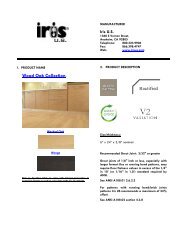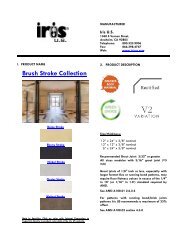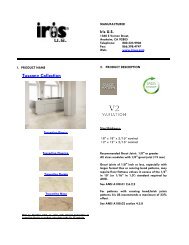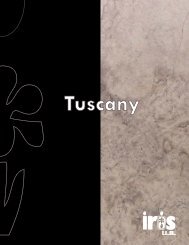You also want an ePaper? Increase the reach of your titles
YUMPU automatically turns print PDFs into web optimized ePapers that Google loves.
How a floor is laid is of great importance. A well-laid floor enhances all of the aesthetic qualities of the material<br />
used.<br />
1. Check that the bed (concrete slab) is perfectly level and completely dry and smooth<br />
2. Use a cleaning device, such as a vacuum, to carefully remove dust and residues.<br />
After having chosen a suitable glue and having prepared it following the manufacturer’s instructions, spread the<br />
glue with a smooth spatula and then comb it with the tooth part (1).<br />
<strong>Iris</strong> <strong>US</strong> strongly suggests the use of polymer-modified thin-set mortar. Polymer-modified thin-set mortar will<br />
increase the lifetime of your installation.<br />
For heavy traffic floors, a double layer of glue is recommended (2). Thus, wetting the back of the product<br />
itself with glue (2). This procedure prevents the possible creation of holes that could cause breakage (see the<br />
difference between spreading and double spreading) (3). After approximately 24-48 hours, it is safe to proceed<br />
to grout. The laid floor must be cleaned carefully and then grouted all over its surface using a rubber spatula.<br />
It is advisable to use colors similar to the floor, in order to obtain a harmonious end result.<br />
How to cut:<br />
It is necessary to use suitable, professional tolls, always checking their cutting capacity and replacing worn<br />
parts when necessary. For accurate cutting use a traditional cutter, checking the state of the cutting wheel<br />
before starting.<br />
For circular cutting, after having made a template (that is to say a pattern of the part to be cut), lay it on the part<br />
in question and transfer the shape with a pencil. Using a diamond-cutting disk, cut without exerting excessive<br />
pressure (4-5).<br />
How to make holes:<br />
It is necessary to use a water milling cutter or a continuous crown diamond-cutting disk for stoneware and<br />
granite tiles. After having penciled (6) – on the back of the product – the perimeter of a square within which<br />
the hole must be made, use the cutting tool to cut perpendicular and diagonal lines and then concentric circles<br />
towards the outside (7). The pictures at the side illustrate in detail the cuts to follow.<br />
When the central thickness of the hole has become very thin, turn the piece over and open up the hole by<br />
tapping lightly (8).<br />
For making holes in tiles, a diamond point drill for granite must be used. It is important to remember to cool<br />
the points often while working.<br />
Installation<br />
99









